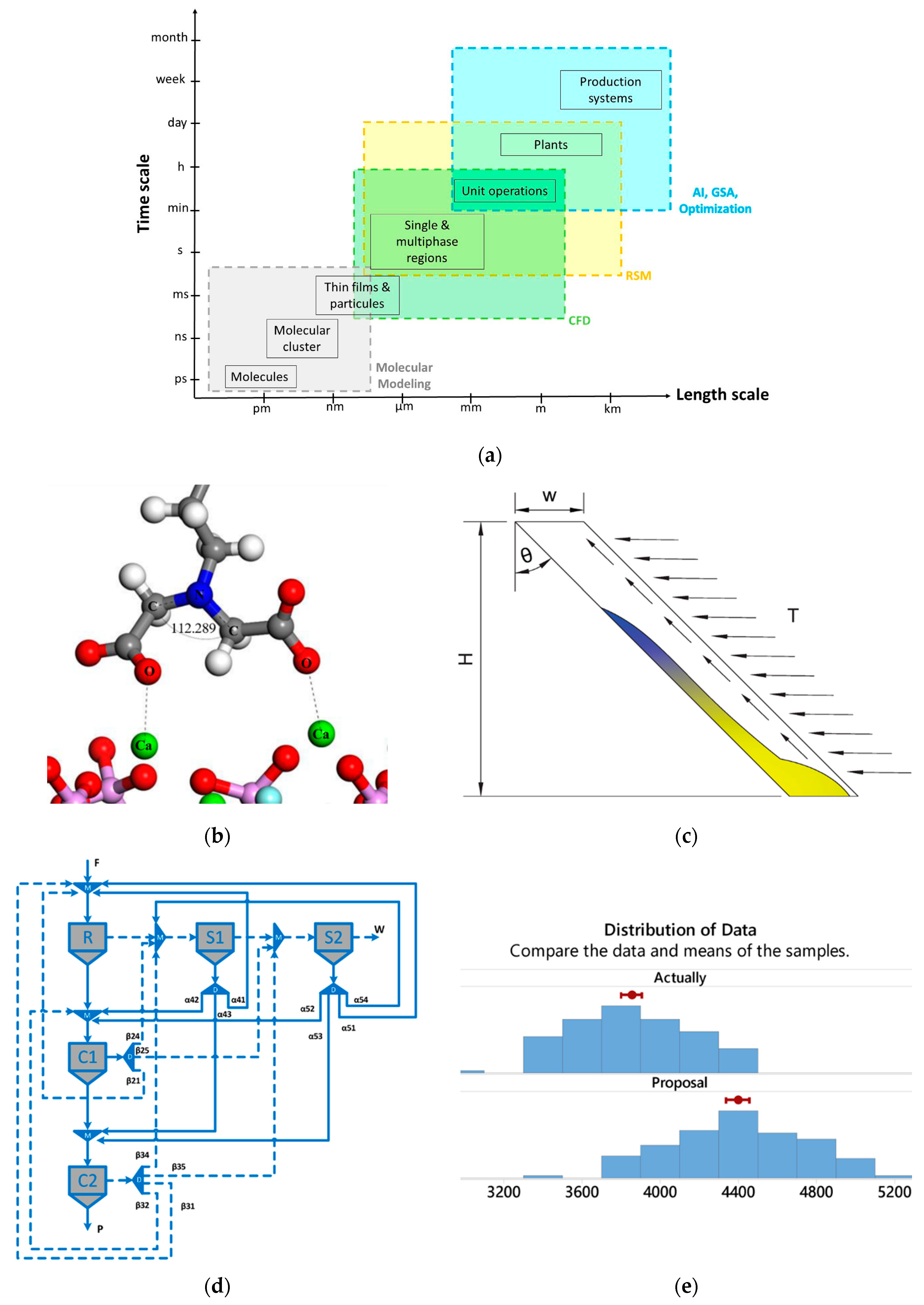Editorial for Special Issue “Modeling, Design and Optimization of Multiphase Systems in Minerals Processing”
Acknowledgments
Conflicts of Interest
References
- Mote, C.D.; Dowling, D.A.; Zhou, J. The power of an idea: The international impacts of the grand challenges for engineering. Engineering 2016, 2, 4–7. [Google Scholar] [CrossRef] [Green Version]
- Schlör, H.; Venghaus, S.; Zapp, P.; Marx, J.; Schreiber, A.; Hake, J.F. The energy-mineral-society nexus—A social LCA model. Appl. Energy 2018, 228, 999–1008. [Google Scholar] [CrossRef]
- Cai, M.; Brown, E.T. Challenges in the mining and utilization of deep mineral resources. Engineering 2017, 3, 432–433. [Google Scholar] [CrossRef]
- Cisternas, L.A.; Lucay, F.A.; Botero, Y.L. Trends in modeling, design, and optimization of multiphase systems in minerals processing. Minerals 2019, 10, 22. [Google Scholar] [CrossRef] [Green Version]
- Shu, S.; Vidal, D.; Bertrand, F.; Chaouki, J. Multiscale multiphase phenomena in bubble column reactors: A review. Renew. Energy 2019, 141, 613–631. [Google Scholar] [CrossRef]
- Engquist, B.; Li, X.; Ren, W.; Vanden-Eijnden, E. Heterogeneous multiscale methods: A review. Commun. Comput. Phys. 2007, 2, 367–450. [Google Scholar]
- Liu, T.Y.; Schwarz, M.P. CFD-based multiscale modelling of bubble–particle collision efficiency in a turbulent flotation cell. Chem. Eng. Sci. 2009, 64, 5287–5301. [Google Scholar] [CrossRef]
- Ludwig, A.; Kharicha, A.; Wu, M. Modeling of multiscale and multiphase phenomena in materials processing. Metall. Mater. Trans. B 2014, 45, 36–43. [Google Scholar] [CrossRef]
- Jamett, N.; Cisternas, L.A.; Vielma, J.P. Solution strategies to the stochastic design of mineral flotation plants. Chem. Eng. Sci. 2015, 134, 850–860. [Google Scholar] [CrossRef] [Green Version]
- Sepúlveda, F.D.; Cisternas, L.A.; Gálvez, E.D. The use of global sensitivity analysis for improving processes: Applications to mineral processing. Comput. Chem. Eng. 2014, 66, 221–232. [Google Scholar] [CrossRef]
- Lucay, F.A.; Gálvez, E.D.; Salez-Cruz, M.; Cisternas, L.A. Improving milling operation using uncertainty and global sensitivity analyses. Miner. Eng. 2019, 131, 249–261. [Google Scholar] [CrossRef]
- Lucay, F.; Cisternas, L.A.; Gálvez, E.D. Global sensitivity analysis for identifying critical process design decisions. Chem. Eng. Res. Des. 2015, 103, 74–83. [Google Scholar] [CrossRef]
- Zhang, C.; Xu, Z.; Hu, Y.; He, J.; Tian, M.; Zhou, J.; Zhou, Q.; Chen, S.; Chen, D.; Chen, P.; et al. Novel insights into the hydroxylation behaviors of α-quartz (101) surface and its effects on the adsorption of sodium oleate. Minerals 2019, 9, 450. [Google Scholar] [CrossRef] [Green Version]
- Nan, N.; Zhu, Y.; Han, Y.; Liu, J. Molecular modeling of interactions between N-(Carboxymethyl)-N-tetradecylglycine and fluorapatite. Minerals 2019, 9, 278. [Google Scholar] [CrossRef] [Green Version]
- He, J.; Han, H.; Zhang, C.; Hu, Y.; Yuan, D.; Tian, M.; Chen, D.; Sun, W. New insights into the configurations of lead(II)-benzohydroxamic acid coordination compounds in aqueous solution: A combined experimental and computational study. Minerals 2018, 8, 368. [Google Scholar] [CrossRef] [Green Version]
- Reyes, C.; Ihle, C.F.; Apaz, F.; Cisternas, L.A. Heat-assisted batch settling of mineral suspensions in inclined containers. Minerals 2019, 9, 228. [Google Scholar] [CrossRef] [Green Version]
- Lucay, F.; Gálvez, E.; Cisternas, L. Design of flotation circuits using tabu-search algorithms: Multispecies, equipment design, and profitability parameters. Minerals 2019, 9, 181. [Google Scholar] [CrossRef] [Green Version]
- Saldaña, M.; Toro, N.; Castillo, J.; Hernández, P.; Navarra, A. Optimization of the heap leaching process through changes in modes of operation and discrete event simulation. Minerals 2019, 9, 421. [Google Scholar] [CrossRef] [Green Version]
- Meng, S.; Li, X.; Yan, X.; Wang, L.; Zhang, H.; Cao, Y. Turbulence models for single phase flow simulation of cyclonic flotation columns. Minerals 2019, 9, 464. [Google Scholar] [CrossRef] [Green Version]
- Juárez Tapia, J.; Patiño Cardona, F.; Roca Vallmajor, A.; Teja Ruiz, A.; Reyes Domínguez, I.; Reyes Pérez, M.; Pérez Labra, M.; Flores Guerrero, M. Determination of dissolution rates of Ag contained in metallurgical and mining residues in the S2O32−-O2-Cu2+ system: Kinetic analysis. Minerals 2018, 8, 309. [Google Scholar] [CrossRef] [Green Version]
- Liu, S.; Han, C.; Liu, J. Study of K-feldspar and lime hydrothermal REACTION: Phase and mechanism with reaction temperature and increasing Ca/Si ratio. Minerals 2019, 9, 46. [Google Scholar] [CrossRef] [Green Version]
- Liddell, K.C. Shrinking core models in hydrometallurgy: What students are not being told about the pseudo-steady approximation. Hydrometallurgy 2005, 79, 62–68. [Google Scholar] [CrossRef]
- Meuwly, M. Reactive molecular dynamics: From small molecules to proteins. Wiley Interdiscip. Rev. Comput. Mol. Sci. 2019, 9, e1386. [Google Scholar] [CrossRef] [Green Version]
- Cisternas, L.A.; Lucay, F.A.; Acosta-Flores, R.; Gálvez, E.D. A quasi-review of conceptual flotation design methods based on computational optimization. Miner. Eng. 2018, 117, 24–33. [Google Scholar] [CrossRef]
- Noble, A.; Luttrell, G.H.; Amini, S.H. Linear circuit analysis: A tool for addressing challenges and identifying opportunities in process circuit design. Mining, Metall. Explor. 2019, 36, 159–171. [Google Scholar] [CrossRef]
- Radmehr, V.; Shafaei, S.; Noaparast, M.; Abdollahi, H. Optimizing flotation circuit recovery by effective stage arrangements: A case study. Minerals 2018, 8, 417. [Google Scholar] [CrossRef] [Green Version]
- Cisternas, L.A.; Acosta-Flores, R.; Gálvez, E.D. Some limitations and disadvantages of linear circuit analysis. In Proceedings of the 7th International Computational Modelling Symposium (Computational Modelling ’19), Falmouth, UK, 11–12 June 2019. [Google Scholar]

© 2020 by the author. Licensee MDPI, Basel, Switzerland. This article is an open access article distributed under the terms and conditions of the Creative Commons Attribution (CC BY) license (http://creativecommons.org/licenses/by/4.0/).
Share and Cite
Cisternas, L.A. Editorial for Special Issue “Modeling, Design and Optimization of Multiphase Systems in Minerals Processing”. Minerals 2020, 10, 134. https://doi.org/10.3390/min10020134
Cisternas LA. Editorial for Special Issue “Modeling, Design and Optimization of Multiphase Systems in Minerals Processing”. Minerals. 2020; 10(2):134. https://doi.org/10.3390/min10020134
Chicago/Turabian StyleCisternas, Luis A. 2020. "Editorial for Special Issue “Modeling, Design and Optimization of Multiphase Systems in Minerals Processing”" Minerals 10, no. 2: 134. https://doi.org/10.3390/min10020134




